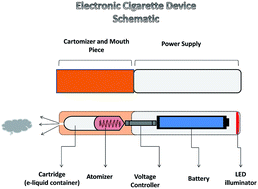Particulate metals and organic compounds from electronic and tobacco-containing cigarettes: comparison of emission rates and secondhand exposure†
Abstract
In recent years, electronic cigarettes have gained increasing popularity as alternatives to normal (tobacco-containing) cigarettes. In the present study, particles generated by e-cigarettes and normal cigarettes have been analyzed and the degree of exposure to different chemical agents and their emission rates were quantified. Despite the 10-fold decrease in the total exposure to particulate elements in e-cigarettes compared to normal cigarettes, specific metals (e.g. Ni and Ag) still displayed a higher emission rate from e-cigarettes. Further analysis indicated that the contribution of e-liquid to the emission of these metals is rather minimal, implying that they likely originate from other components of the e-cigarette device or other indoor sources. Organic species had lower emission rates during e-cigarette consumption compared to normal cigarettes. Of particular note was the non-detectable emission of polycyclic aromatic hydrocarbons (PAHs) from e-cigarettes, while substantial emission of these species was observed from normal cigarettes. Overall, with the exception of Ni, Zn, and Ag, the consumption of e-cigarettes resulted in a remarkable decrease in secondhand exposure to all metals and organic compounds. Implementing quality control protocols on the manufacture of e-cigarettes would further minimize the emission of metals from these devices and improve their safety and associated health effects.


 Please wait while we load your content...
Please wait while we load your content...